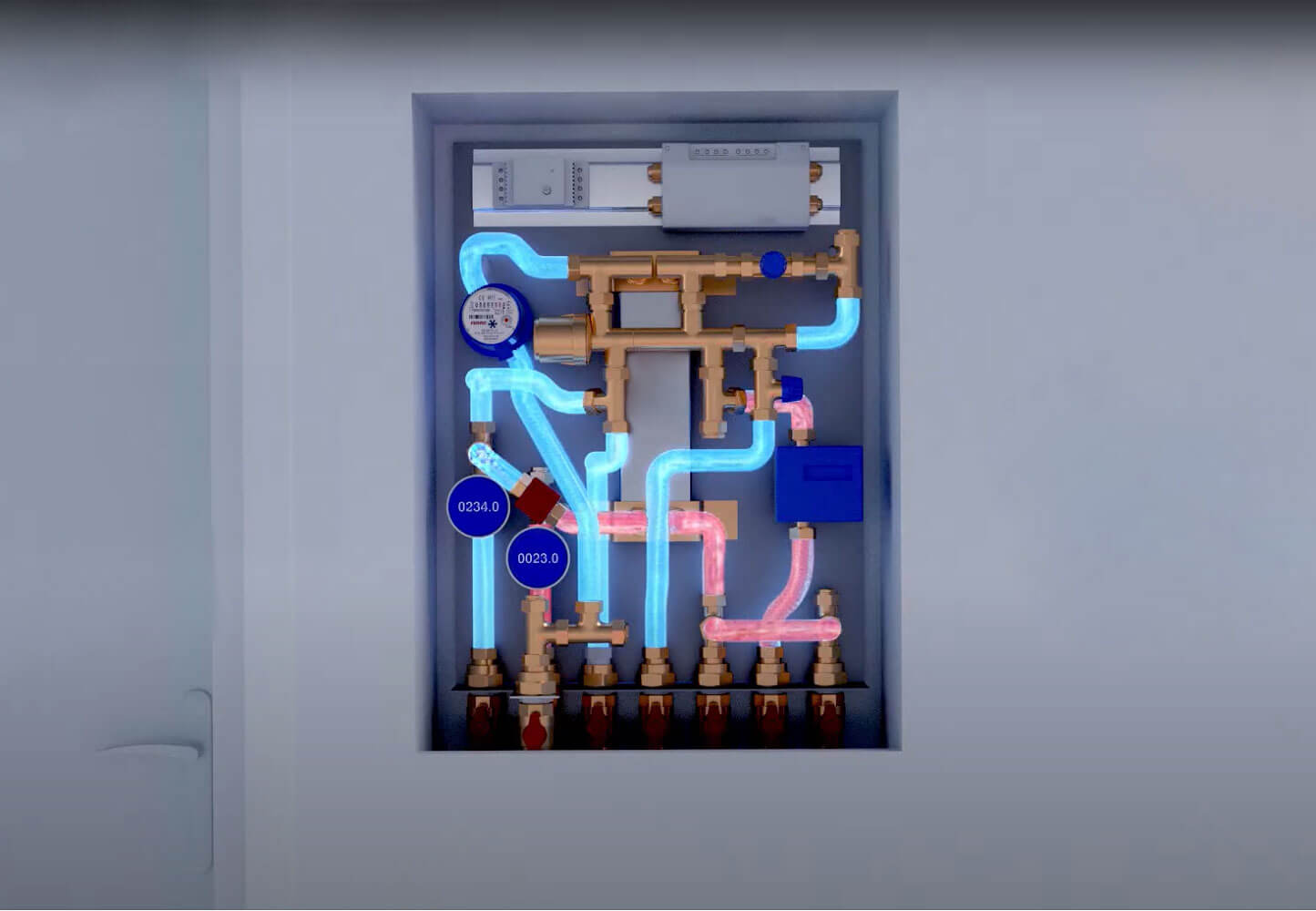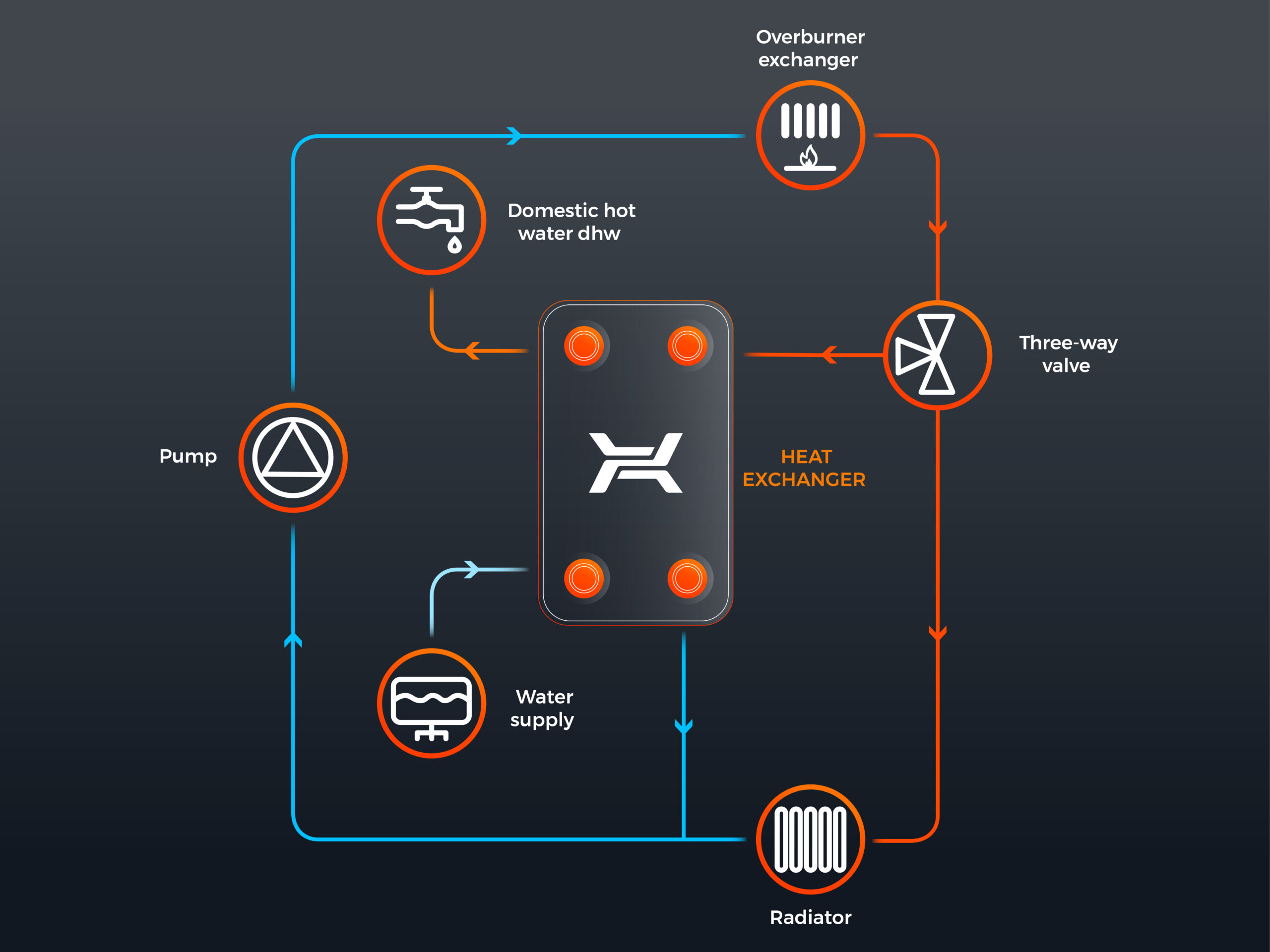Heating
A division of the energy industry, supplying heat from a heat generating plant or a combined heat and power plant to centralized heating systems.

A division of the energy industry, supplying heat from a heat generating plant or a combined heat and power plant to centralized heating systems.

The heating system has three main components: the heat source, such as a combined heat and power plant or heat generating plant; the heating grid, through which hot water or water vapor is sent to the recipients and district heating substations, which collect the heat at buildings. System heat reaches millions of recipients every day. Hexonic has its part in this. As a supplier of heat exchangers, we supply most of the heating companies in Poland. Our exchangers also operate in the world's largest heating systems.
The devices most often used in district heating substations are brazed plate exchangers, which are reliable and durable devices, but most importantly offer an extensive range of types. This allows their application both in small, residential stations, as well as in distribution stations supplying multi-family and public buildings. District heating substations may also be built using shell and tube exchangers, such as JAD or HAD.
District heating substations are systems located at the junction of a city’s heating grid and the internal system of a building.
One of the substation types is a single-function substation. Unlike two-function substations, it operates only for one consumer circuit, usually the central heating (CH) system, or it supplies the residential district heating substations (also called individual apartment substations). In this situation, domestic hot water (DHW) is heated by individual heat sources, e.g. gas-fired boilers, using a DHW storage tank with a coil or through mini-substations redirecting heat from the collective substation for the purposes of CH and DHW at individual apartments.
The task of a single-function district heating substation is transferring heat from a heating grid to the building’s central heating grid through a plate or shell and tube heat exchanger. This allows to achieve a lower temperature and pressure in the system than in the heating grid, which is safer for the end user.
Hexonic’s extensive product range provides a selection of exchangers for district heating substations of virtually any size. This application uses the series L brazed plate exchangers, also with the Luna or SafePLATE options, or JAD and HAD type shell and tube heat exchangers.

Heat from a heating grid is transmitted into the system inside a building using a district heating substation.
One of the types of such substations is a two-function district heating substation. Unlike a single-function substation, its role is to supply heat to two heating circuits – most often a central heating and a domestic hot water circuit. This is possible by combining two heat exchangers, operating independently in a parallel system.
Exchangers most often used in heating substations are plate or shell and tube JAD-type exchangers.

A residential substation, also called individual apartment substation, is a compact device providing heat to a single apartment. It transfers the heat from a local boiler room or a district heating substation supplied by a city heating grid to the apartment. Such a solution provides the occupants of multi-family buildings with individual control over how they use heating and prepare domestic hot water.
The heat transfer process in the individual apartment district heating substations occurs with the help of brazed plate heat exchangers. The L-series brazed plate exchangers, also with the Luna and SafePLATE options, are used in this application.

Gas-fired boilers are heating devices characterized by a high efficiency and performance. There are several kinds of boilers.
Gas-fired combination boilers have been designed in a way that enables the unit to heat the building and supply domestic hot water (DHW) heated in a flow system. If hot water is needed, the boiler will switch to heating water drawn from a tapping point and, after a while, return to heating water for central heating (CH) purposes.
The main task of a single-function boiler is heating the water in a CH system. In order to use this type of boiler for heating DHW, it needs to be equipped with a DHW cylinder. The coil located inside the cylinder, which is supplied with hot water from the boiler, maintains the set water temperature.
Both types of boilers may be equipped with a flue gas heat recovery function, which allows for achieving lower operation costs. This phenomenon is called condensation and the boilers are called condensing boilers.
Boiler operation is enabled by a compact heat exchanger placed inside it. Most often, it is a brazed plate exchanger. It ensures a high comfort of usage and excellent performance of the entire system. Its compact size allows to reduce the dimensions of the entire boiler.

Hot water prepared in accordance with the user’s set points, e.g. in a district heating substation, flows constantly through the heaters. A circulating pump, which pumps water to the heater, enables hot water circulation. Any change in the water’s parameters, in particular a temperature drop, may cause the water in the tubes to freeze. Temperature is additionally lowered by a cold air jet that collects heat from the heater ribbing. When the circulation stops, water cools down rapidly and freezes. Frozen water inside the pipes may damage them, thus causing the room to be flooded and forcing repairs.
Glycol solutions are used in order to protect the heater against freezing. A glycol heat exchanger guarantees that the required capacity is maintained. A glycol heat exchanger is a device using a (ethylene or propylene) glycol solution as the working medium for cooling or heating the air flowing through the heat exchanger. Glycol is used in order to prevent the fluid from freezing and possibly damaging the heat exchanger as a result. It’s lower specific heat decreases the exchanger parameters in comparison to a water heat exchanger.
In a steam heating system, rooms are equipped with a heater, which is connected to a low-pressure steam source (boiler). The steam entering a heat receiver is condensed and releases latent heat, returning to liquid state water. Consequently, the heater heats the air in the room. Condensing water is returned to the boiler by gravity or using a pump in order to get heated again.
High-raise buildings use low steam density to avoid excessive pressure required to circulate hot water from a boiler installed in the basement. In industrial systems, process steam is used for power generation and room heating.